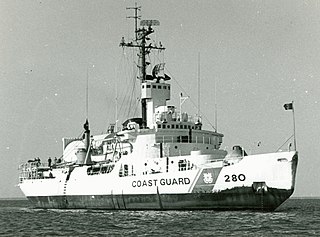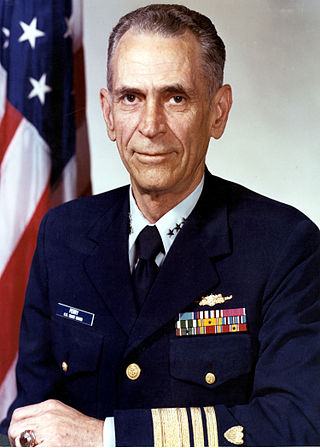Related Research Articles

Russell Randolph Waesche, Sr. served as the eighth Commandant of the United States Coast Guard from 1936 to 1946, overseeing the service during World War II. He was the U.S. Coast Guard's longest serving commandant, having served ten years in that post. In addition, he was the first officer to hold the ranks of vice admiral and admiral within the Coast Guard.

USS Edisto (AGB-2) was a Wind-class icebreaker in the service of the United States Navy and was later transferred to the United States Coast Guard as USCGC Edisto (WAGB-284). She was named after Edisto Island, South Carolina. The island is named after the Native American Edisto Band who inhabited the island and the surrounding area. As of 2011 there is a namesake cutter USCGC Edisto (WPB-1313). The newer Edisto is a 110-foot Island-class patrol boat and is stationed in San Diego County, California.

USS Bear was a dual steam-powered and sailing ship built with six-inch (15.2 cm)-thick sides which had a long life in various cold-water and ice-filled environments. She was a forerunner of modern icebreakers and had a diverse service life. According to the United States Coast Guard official website, Bear is described as "probably the most famous ship in the history of the Coast Guard."

The Wind-class icebreakers were a line of diesel electric-powered icebreakers in service with the United States Navy, United States Coast Guard, Royal Canadian Navy, Canadian Coast Guard and Soviet Navy from 1944 through the late 1970s. They were very effective ships: all except Eastwind served at least thirty years, and Northwind served in the USCG continuously for forty-four years. Considered the most technologically advanced icebreakers in the world when first built, the Wind-class icebreakers were also heavily armed; the first operator of the class was the United States Coast Guard, which used the vessels for much-needed coastal patrol off Greenland during World War II. Three of the vessels of the class, Westwind, Southwind, and the first Northwind all went on to serve temporarily for the Soviet Union under the Lend-Lease program, while two others were built for the United States Navy and another was built for the Royal Canadian Navy; all eight vessels were eventually transferred to the United States Coast Guard and the Canadian Coast Guard.

USCGC Staten Island (WAGB-278) was a United States Coast Guard Wind-class icebreaker. Laid down on 9 June 1942 and launched on 28 December 1942, the ship was commissioned on 26 February 1944, and almost immediately afterward transferred to the Soviet Union, under the Lend Lease program, under the name Severny Veter, which loosely translates as Northwind, until 19 December 1951. When returned to the United States Navy, she was designated USS Northwind until 15 April 1952, when she was renamed Staten Island to distinguish her from her successor USCGC Northwind (WAGB-282) which had been laid down shortly after she was lent to the Soviet Union. The ship was transferred to the U.S. Coast Guard as USCGC Staten Island in February 1965, and served until November 1974, before being scrapped.

USCGC Southwind (WAGB-280) was a Wind-class icebreaker that served in the United States Coast Guard as USCGC Southwind (WAG-280), the Soviet Navy as the Admiral Makarov, the United States Navy as USS Atka (AGB-3) and again in the U.S. Coast Guard as USCGC Southwind (WAGB-280).

Charles Ward "Tommy" Thomas was a flag officer in the United States Coast Guard and commanding officer of the icebreakers USCGC Northland (WPG-49) and USCGC Eastwind (WAGB-279) that served in the Greenland Patrol during World War II. In August 1945 he was appointed commander of Greenland Patrol. After the war he was commanding officer of USCGC Northwind (WAGB-282) during Operation Highjump; The United States Navy Antarctic Developments Project 1946–1947, also known as the Fourth Byrd Antarctic Expedition. Later followed expeditions in the Bering Sea.
Lyndon Spencer was a Vice Admiral in the United States Coast Guard.
Richard A. Appelbaum is a retired Rear Admiral in the United States Coast Guard.
Harold G. Bradbury was a rear admiral in the United States Coast Guard.
Robert A. Duin was a rear admiral in the United States Coast Guard.
Arthur B. Engel was a rear admiral in the United States Coast Guard. At different points in his maritime career, he served as Superintendent of the United States Coast Guard Academy at New London, Connecticut and as Superintendent of the United States Merchant Marine Academy at Kings Point, New York.
William J. Keester was a rear admiral in the United States Coast Guard.
Robert S. Lucas was a rear admiral in the United States Coast Guard.
Carl Baker Olsen was a rear admiral in the United States Coast Guard.

Ellis L. Perry was a vice admiral and Vice Commandant of the United States Coast Guard.

Thomas Reece Sargent III was a vice admiral and Vice Commandant of the United States Coast Guard.
Allen Winbeck (1905–1990) was an American military officer who served as a rear admiral in the United States Coast Guard.
Theodore Joseph Wojnar is a former rear admiral in the United States Coast Guard.
Donald McGregor Morrison was a Vice Admiral in the United States Coast Guard who served as the 8th Vice Commandant from 1962 to 1964.
References
- ↑ "Rear Admiral Edward H. Thiele" (PDF). United States Coast Guard. Retrieved 2014-05-07.